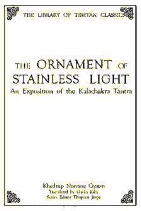Published by Wisdom, 672pp Translation: Gavin Kilty and Thubten
Jinpa
 Available
from Snow
Lion
Available
from Snow
Lion
Snowlion:
The inaugural volume of Thupten Jinpa's LIBRARY OF TIBETAN CLASSICS,
released to coincide with the Dalai Lama's conferral of the initiation
rite of Kalachakra in Toronto in April 2004. The text develops the highly
complex theory of correlation beween the internal elements within a
living human body and the elements of the external world, and gives
a detailed account of Tibetan astronomy.
Review
by Andy Wistreich from Mandala Magazine:
Overall
Rating: 
His Holiness
the Dalai Lama himself selected Ornament of Stainless Light by Khedrup
Norsang Gyatso (d.1613) for Geshe Dr Thubten Jinpa's new 'Library of Tibetan Classics'
series. Gavin Kilty's translation of this commentary on the Vimalaprabha
is scholarly and practical, his lucid introduction demonstrating his excellent
grasp of the subject matter. Gavin consulted Kirti Tsenshap Rinpoche, Jhado Rinpoche
(Abbot of Namgyal Monastery), and Edward Henning, a western expert on the Kalacakra
calendar and cosmology. This commentary gives ready access to Vimalaprabha,
itself a commentary on the abbreviated tantra. So through this one book we can
learn all the important points of the Kalacakratantra.
In Kalacakra
Sadhana and Social Responsibility, David Reigle shows how the Kalacakratantra
performed an influential role at critical moments in the spiritual evolution of
the world. The first was the initial revelation, when Buddha gave it to Suchandra,
King of Shambhala. After 600 years, Manjushri Yashas (a later king of Shambhala)
initiated the Brahmin sages into the Kalacakra mandala, to sustain the spiritual
integrity of Shambhala when non-Indic forces threatened it. Later, the Kalacakra
surfaced in India in the early eleventh century, appropriately being lifted to
Tibet just before the suppression of Indian Buddhism. Thus, this most scientific
of Buddhist systems underlay the entire Tibetan Buddhist culture of the second
millennium C.E.
Today, one thousand years later, at a new turning point
in the spiritual history of the world, Kalacakra wisdom re-emerges as a power
for good. The Buddhist Middle Way view of reality lights a way beyond post-structuralist
thought and post-modern culture. The Kalacakratantra understanding that
empty particles underpin all matter, and that karmic winds are the medium of connectivity
between the individual and the cosmos, supplements contemporary knowledge both
of particle physics and of the origins of the universe. The socially inclusive,
anti-elitist social philosophy of the Vimalaprabha offers a spiritual framework
for contemporary multi-culturalism and urban internationalisation.
Stimulated
by the frequency of Kalacakra Initiations by masters such as His Holiness the
Dalai Lama and Kirti Tsenshap Rinpoche, the Kalacakra is enjoying a worldwide
revival. Kalacakra practice groups are forming in several countries, linked by
the International Kalacakra Network (IKN), which provides information, email groups
and materials in many languages to initiates. New translations of Vimalaprabha
from Sanskrit, such as those by Vesna Wallace
and Sofia Stril-Rever, root contemporary Kalacakra
studies in original sources. The IKN has recently commissioned Gavin to continue
his work on Kalacakra by translating the long sadhana, and a commentary on the
generation process, to support an oral commentary by Jhado Rinpoche, planned for
2005 in Europe. Gavin's translation of Ornament of Stainless Light has
an immediate style that will appeal to this audience.
In the first two of
the five parts of Norsang Gyatso;s book (The External World and The
Inner World of Sentient Beings) we engage with history, science and philosophy
- the nature and origins of the universe, the place of sentient beings in it,
the processes of the individual, and the common basis of person and cosmos.
For
example, relate this passage on the formation of the universe, to the latest scientific
understanding:
'During this time of emptiness the subtle particles of these
five elements exist as isolated fragments and are not in any conventional sense
objects of the sensory powers of the eye and so forth. They are known as empty
particles and remain isolated in empty space. When the potential of the collective
karma of sentient beings is ripened, the subtle air particles come together to
form air whose nature is light and moving.'
Descriptions of Kalacakra practices
for personal transformation appear in the latter three parts (Initiations,
Sadhana: Methods of Accomplishment and Gnosis: A Presentation
of the Completion Stage). Most readers will find some sections challenging.
For example, those on the movement of the planets, and other scientific subjects
are hard going. However, those who practice tantra can use these topics to help
them recognise the intimate connection between inner and outer worlds, on which
enlightened transformation is based.
Whether you are a Kalacakra practitioner,
a student of Tibetan Buddhism or interested in science from a new angle, this
book is worthy of study.
Please share your opinion of this book
with us.
Please note that
we added links to Snow
Lion for many of the books;
if you intend to order these (or other) books
online with them,
then clicking on our links will generate some money for
us to keep the Network going.